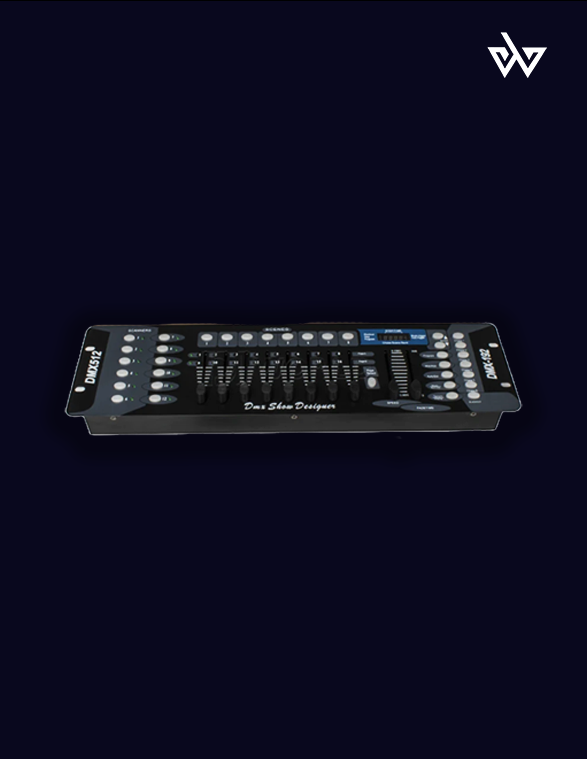
DMX Controllers for Beginners: How to Gain Complete Control Over Your Lighting
Share
If you are already familiar with basic lighting such as LED pars, moving heads, or lasers, and you want to be able to control these effects better, a DMX controller is a logical next step. With a DMX controller you can coordinate, program and adjust different lighting effects, giving you full control over the atmosphere and dynamics of your event. But how exactly does a DMX controller work and what do you need to get started? We will explain it to you step by step.
What is a DMX Controller?
A DMX controller is a device that sends out DMX signals to control lights and effects. The DMX protocol (Digital Multiplex) sends signals to all your connected devices via a single cable, allowing you to adjust the color, intensity, speed and movement of your lighting. A DMX controller translates your settings into specific commands for each device in your lighting setup, which ensures a coordinated and professional light show.
Different Types of DMX Controllers
Depending on your experience and the complexity of your light show, you can choose from different types of DMX controllers. Below are the most common types and their applications:
-
Hardware DMX Controllers
These are physical controllers with sliders, buttons, and knobs that allow you to manually control each function. They are usually easy to use and are often used for smaller setups. Hardware controllers are useful if you want to quickly adjust settings without a computer. For beginners, there are simple controllers that control between 8 and 24 channels, which works well for smaller events. -
Software DMX Controllers
Software controllers allow your DMX controller to be controlled via a computer, with your light show programmed using DMX software. This offers much more flexibility and features, such as pre-setting scenes and light patterns, which is perfect for complex shows. You will need a special DMX interface to connect the software to your lighting. -
Standalone DMX Controllers
These controllers are pre-programmed and require minimal manual intervention during the show. This is useful for smaller events or situations where you want to run the show automatically without constant adjustments.
Why Use a DMX Controller?
A DMX controller gives you complete control over your lighting and allows you to create complex and custom light shows. Here are some of the benefits of a DMX controller:
- Easy Coordination : With one controller you can control several lighting devices at the same time, making everything work in sync.
- Programmability : You can pre-program scenes and shows so you don't have to make manual adjustments during the event.
- Precision and Variety : With a DMX controller you can determine exactly which colors, movements, and effects you want to use, which creates a unique atmosphere.
How to Connect a DMX Controller?
To get started with a DMX controller, follow these basic steps:
-
Connect your Enlightenment
Connect the DMX cable from the output of your controller to the input of your first light fixture. Many fixtures have a DMX loop-through capability, which means you can daisy-chain fixtures. -
Do you know your DMX addresses?
Each fixture is assigned a unique DMX address so the controller knows which device it is controlling. Set each fixture to an address that matches the controller configuration. This will ensure that each fixture responds correctly to DMX signals. -
Choose the Right Mode
Lighting has different modes (such as 4-channel, 8-channel, etc.) depending on the available features. Choose a mode that suits your light show and the controller you are using. -
Program your Show
For software controllers, you can program scenes and effects that you save on the controller. For hardware controllers, you can usually preset settings with sliders and buttons. By experimenting with different colors, movements and patterns, you get a unique, customized light show.
Tips for Beginners
If you are just starting out with DMX controllers, these tips may help:
- Start Small : Opt for a simple controller and experiment with a few lights before expanding your setup.
- Try Automatic Scenes : Many controllers have preset scenes that you can use if you don't want to set everything up yourself right away.
- Pay attention to the channels : Make sure you know how many channels your lights use and that your controller supports enough channels. This will prevent frustration during setup.
Conclusion
A DMX controller is a valuable tool for anyone who wants more control over their light show. It gives you the ability to create a professional, dynamic atmosphere, even if you don’t have much experience. Whether you’re hosting a small party or a larger event, a DMX controller will help you create the perfect light show that will really bring your event to life.
Hopefully this guide will help you get started with DMX controllers and set up your first light show!
